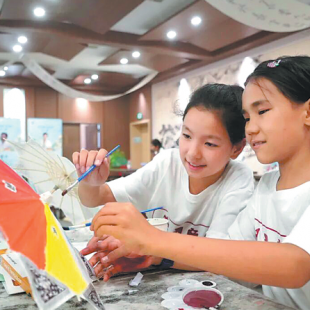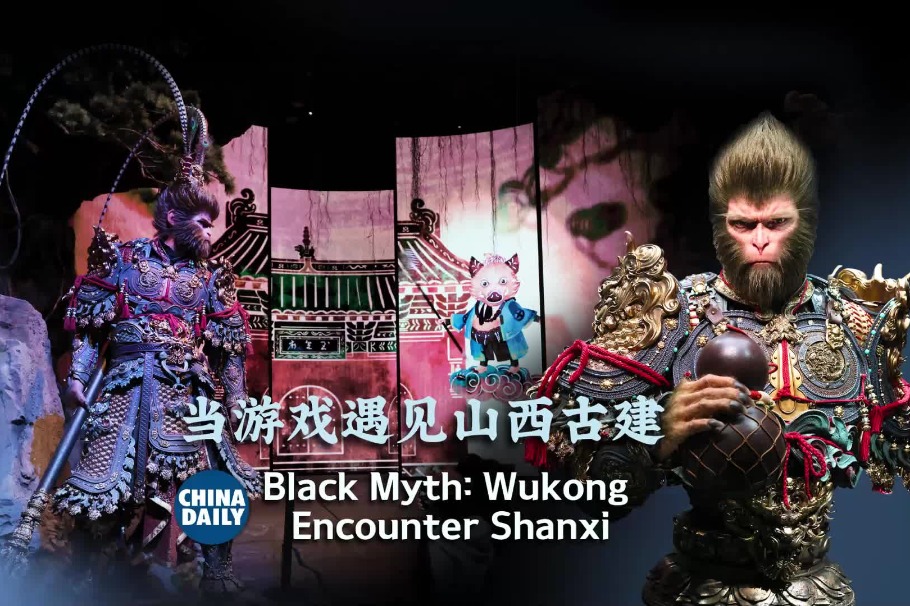Cultural heritage uniting people's identity
Outreach programs and schools playing a role in enriching communities through the power of art


For example, paper-cutting artist Zhou Rui and her students recently guided participants in creating intricate patterns such as pomegranate blossoms, with each piece symbolizing ethnic unity. Additionally, calligrapher He Yang led students in writing classical poetry, helping them perceive the aesthetic beauty of Chinese characters and reflect on the cultural spirit of self-cultivation.
"In today's rapidly evolving society, the fields of culture and technology continue to diversify. For students, it is essential to pursue well-rounded development in moral, intellectual, physical, aesthetic, and labor education, while also inheriting and promoting China's outstanding traditional culture," said Kong Zhaoli, Party secretary of Aksu Tianhang Experimental School.
Living legacy
On the evening of Oct 18, the original song-and-poem performance Oasis Feast — Qorikum Maxrap was staged at a local theater. As a national-level intangible cultural heritage piece, it presented a brilliant show that embodies a century-old legacy.
Qorikum, which means water in the desert, originated in Kartal town, Aksu. Listed as a national intangible cultural heritage item since 2008, it is not just a comprehensive art form integrating music, dance, poetry and games, but a testament to the creativity of the Aksu people within the broader Chinese cultural context.
"The performance was brilliant, full of contemporary energy and ethnic character — it was truly impressive. Not only did I get to experience the charm of Maxrap up close, but I also gained a deeper understanding of Aksu," said audience member Amira Amat.
To promote cultural exchanges and mutual learning among all ethnic groups, the Aksu Kummaxrap Art Troupe held a special performance at Hangzhou Redstar Theatre on Nov 5, allowing audiences in Hangzhou to experience the charm of Xinjiang's intangible cultural heritage firsthand.
During the 2025 "Xinjiang is a Wonderful Place" cultural assistance event, Aksu presented 27 intangible cultural heritage items, including Kalpin embroidery and Kuqa folk instrument making, in a special exhibition held in Hotan. More than 3,000 heritage and cultural innovation exhibits attracted widespread attention.
Inheritors of these traditions demonstrated their skills on-site, where the classic charm of Kalpin embroidery and the contemporary creativity of cultural derivative products were well received.
Efforts will be made to better connect inheritors with market opportunities, ensuring that Aksu's intangible heritage remains not only alive in tradition but vibrant in everyday life, said an official from the Aksu bureau of culture, sports, radio, television and tourism.

More activities have also taken place. In the urban bookstore of Sahpaq village, Eganqi town in Aksu, retired teacher Patigul Aisa led children in a recitation of classical Chinese poetry. The children recited the poem Min Nong, which means sympathy for farmers, in Mandarin. They also created silk patchwork art using Atlas silk to depict the poem's scene of farmers "hoeing crops under the midday sun".
Meanwhile, Xincheng Street organized an intangible cultural heritage handicraft event for the Qixi Festival, where young people learned the arts of lacquer fan-making and tie-dyeing. "Each tie-dye piece is unique. Through creating, we truly felt the charm of traditional culture," said participant Hu Lijun.
Each year, such activities are held about 150 times, engaging over 200,000 residents, local officials said.
Aksu has adopted a multidimensional approach to strengthening the social fabric through cultural development. By establishing cultural centers, integrating traditions into education, and preserving intangible heritage, the city has rooted Chinese cultural traditions in local communities. These efforts enhance the role of culture as a force for unity, providing momentum for Aksu's continued development.





































